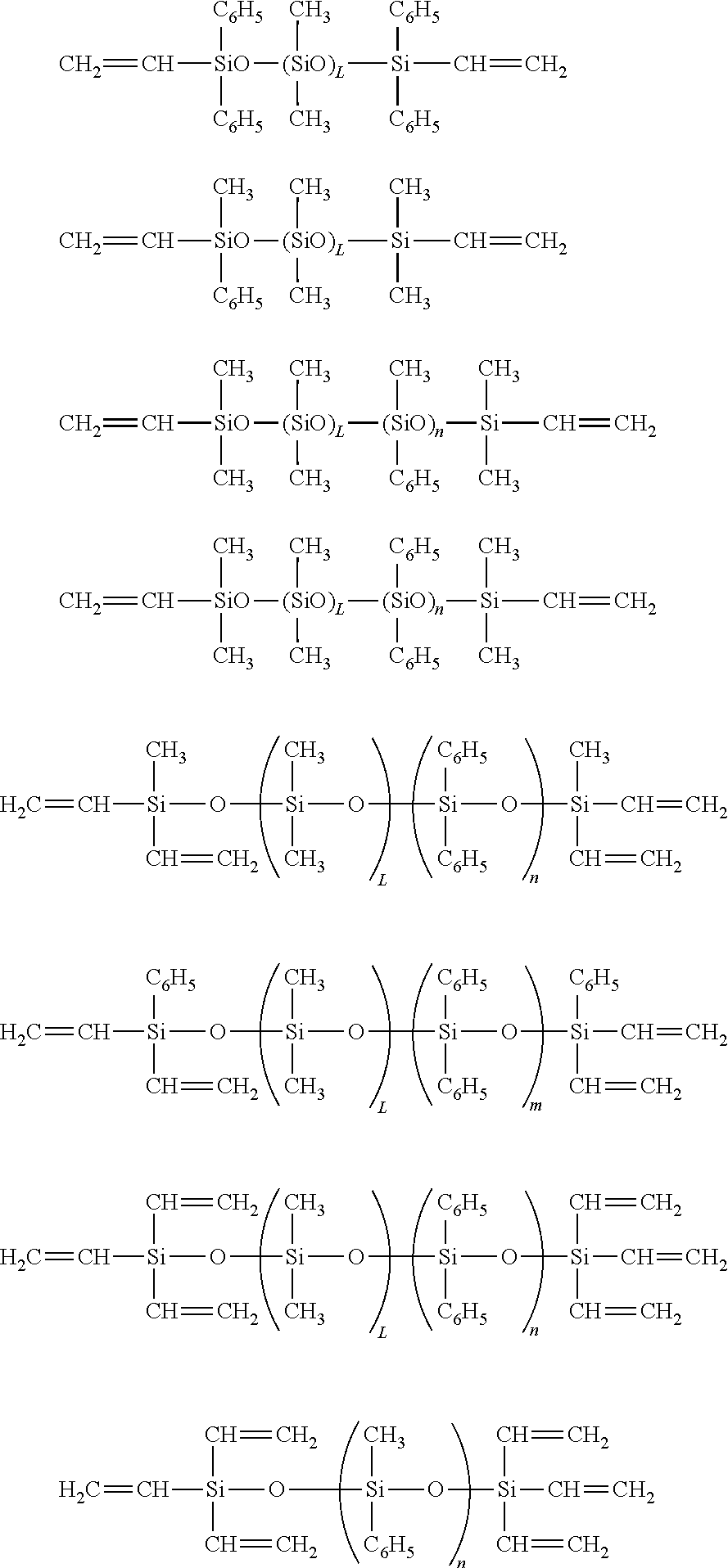Curable silicone rubber composition and cured product thereof
a technology of silicone oil and composition, applied in the direction of physical/chemical process catalysts, metal/metal-oxide/metal-hydroxide catalysts, coatings, etc., can solve the problems of reduced hardness resins produced by adding silicone oil to silicone varnish, occurrence of cracks becomes a problem, and the effect of no dust adhesion
- Summary
- Abstract
- Description
- Claims
- Application Information
AI Technical Summary
Benefits of technology
Problems solved by technology
Method used
Image
Examples
example 1
[0050]To (a) 50 parts of an organopolysiloxane (viscosity: 20,000 mm2 / s) represented by a formula shown below:
[0051]
(wherein, L=413 and m=85)
were added (b) 50 parts of a resin-structure vinylphenylmethylpolysiloxane (PVMQ) comprising 50 mol % of SiO2 units, 42.5 mol % of (CH3)3SiO0.5 units, and 7.5 mol % of MePhViSiO0.5 units, (c) a sufficient quantity of an organohydrogenpolysiloxane represented by a formula shown below to provide 1.5 mols of SiH groups for each 1 mol of silicon atom-bonded vinyl groups within the components (a) and (b) (hereafter, this ratio of SiH groups to vinyl groups may also be represented using the expression “SiH / SiVi”),
[0052]
(wherein, p=2 and q=8)
and (d) 0.05 parts of an octyl alcohol-modified solution of chloroplatinic acid (platinum element content: 2% by mass), and the resulting mixture was then stirred thoroughly, yielding a silicone rubber composition. This composition was then heat-molded for 4 hours at 150° C., thus forming a cured product. The refr...
example 2
[0053]To (a) 50 parts of an organopolysiloxane (viscosity: 4,000 mm2 / s) represented by a formula shown below:
[0054]
(wherein, L=70 and m=30)
were added (b) 50 parts of a resin-structure vinylphenylmethylpolysiloxane (PVMQ) comprising 50 mol % of SiO2 units, 35 mol % of (CH3)3SiO0.5 units, and 15 mol % of MePhViSiO0.5 units, (c) a sufficient quantity of an organohydrogenpolysiloxane represented by a formula shown below to provide 1.5 mols of SiH groups for each 1 mol of vinyl groups within the components (a) and (b),
[0055]
(wherein, p=4 and q=8)
and (d) 0.05 parts of an octyl alcohol-modified solution of chloroplatinic acid (platinum element content: 2% by mass), and the resulting mixture was then stirred thoroughly, yielding a silicone rubber composition. Using the same procedure as the example 1, cured products were then formed from this composition, and the physical properties of these cured product were measured. The results of each of the measurements are shown in Table 1.
example 3
[0056]30 parts of the organopolysiloxane (a) used in the example 1, 70 parts of the PVMQ (b) used in the example 1, 4.3 parts of the organohydrogenpolysiloxane (c) used in the example 1, and 0.05 parts of the octyl alcohol-modified solution of chloroplatinic acid (d) used in the example 1 were mixed together, and then using the same procedure as the example 1, a silicone rubber composition was prepared, cured products were formed from this composition, and the physical properties of these cured product were measured. The results of each of the measurements are shown in Table 1.
PUM
| Property | Measurement | Unit |
|---|---|---|
| molar ratio | aaaaa | aaaaa |
| molar ratio | aaaaa | aaaaa |
| temperature | aaaaa | aaaaa |
Abstract
Description
Claims
Application Information
 Login to View More
Login to View More - R&D
- Intellectual Property
- Life Sciences
- Materials
- Tech Scout
- Unparalleled Data Quality
- Higher Quality Content
- 60% Fewer Hallucinations
Browse by: Latest US Patents, China's latest patents, Technical Efficacy Thesaurus, Application Domain, Technology Topic, Popular Technical Reports.
© 2025 PatSnap. All rights reserved.Legal|Privacy policy|Modern Slavery Act Transparency Statement|Sitemap|About US| Contact US: help@patsnap.com



